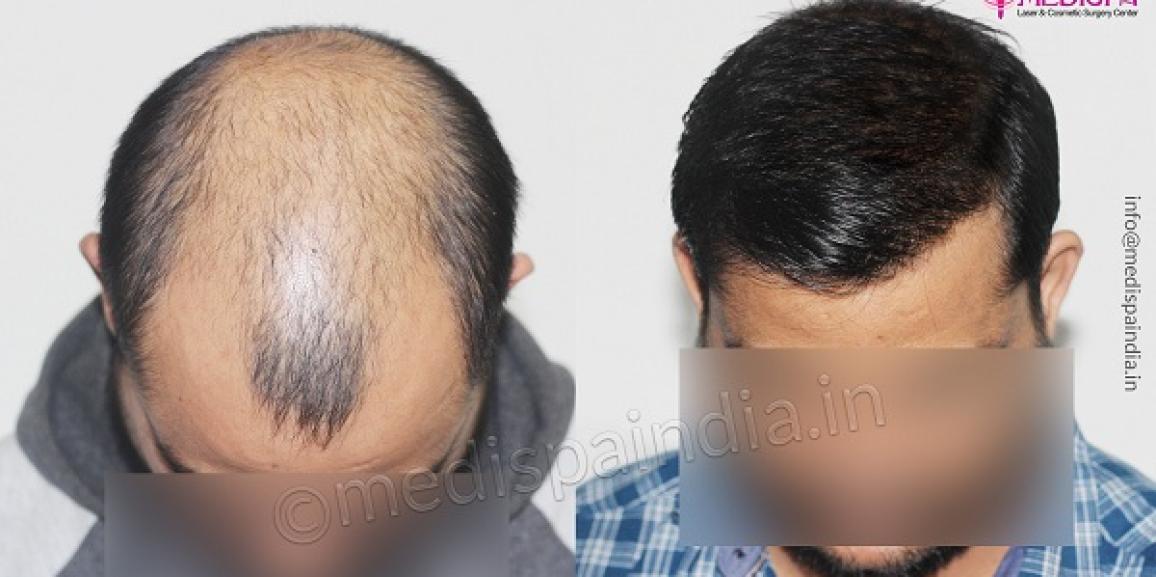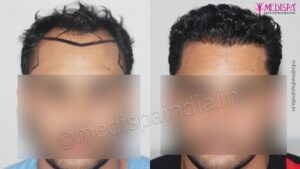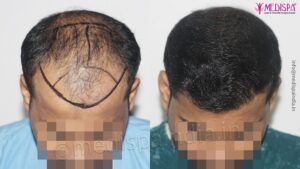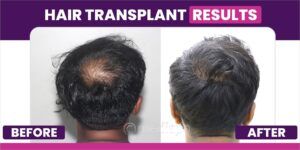
Patients with all degrees of baldness seek treatment for their hair loss on a regular basis, and thousands of them have had the best possible hair transplant results with maximum hair density and natural-looking results with medispa hair transplant clinic. The severity of baldness has a significant role in determining many aspects of the hair transplant procedure.
Norwood Classification for grading of baldness
Pattern baldness, also known as androgenic alopecia, begins in the frontal or temporal triangles and advances to a bigger, broader bald area, leaving just a band of hair at the back and sides of the head in advanced stages of baldness. Baldness is classified into stages and is often represented by the Norwood baldness grades, which are stated as follows:
Class I: Entire hairline lies high on the forehead and is not actually balding.
Class II: Triangular areas of recession in the sides of frontal area and minimal recession on mid frontal area.
Class III: Borderline case. Deepening of triangular recession or can include thinning of hair on the vertex.
Class IV: Further frontal hair loss and widening of hair loss from vertex but still a wide band of hair present separating frontal and vertex hair loss.
Class V: Widening of frontal and vertex hair loss and continual breaking of separation line of hairs between frontal and vertex baldness.
Class VI: Band or bridge of hair disappear merging frontal and vertex baldness.
Class VII: A band of hair presents only in back and side of the head.
Hair graft calculator
The hair graft calculator is a useful tool for determining the level of baldness and the number of hair grafts required to undertake a successful hair transplant treatment. The hair graft calculator is provided on the Medispa hair transplant clinics’ official website and is very easy to use and understand.
Treatment modalities for hair loss
Except for a high protein and vitamin-rich diet, temporary hair loss requires no medical intervention. Pattern baldness or permanent baldness, on the other hand, necessitates medical care and a tailored treatment strategy.
For the time being, the following therapy techniques are available for the treatment of hair loss:
- Drugs: Minoxidil and finasteride are two medications that can be used to treat hair loss. These drugs have been shown to slow the development of hair loss and promote hair growth.
- PRP: Platelets are one of the biological components of blood that play a critical part in the healing and clotting mechanisms. PRP therapy is a concentrated form of platelet therapy that contains 5-6 times the typical platelet count. Platelets generate growth factors, which offer a nutrient-rich environment for cells to develop and divide more effectively. Given the increased concentration of platelets in PRP, the concentration of growth factors is quite high. As a result, at the injected site, higher hair development and slower hair loss are expected.
- Hair transplant: Hair transplantation has emerged as the most effective treatment for baldness. Is this a true statement? Let’s find out!
Hair transplantation is, without a doubt, the most effective approach to treat baldness. Hair transplantation is becoming increasingly popular among hair loss sufferers due to the numerous benefits it provides.
Procedure: Hair transplantation is a small surgical treatment that involves removing hair follicles from a specific part of your body known as the donor location. The permanent hair roots exist in these donor sites, which frequently include the back and sides of the head, chest, axilla, and beard. Hair follicles are removed in the desired number and then carefully implanted to the bald area.
Hair transplant procedure and recovery?
Hair transplantation is a precise surgical treatment for restoring baldness or hair thinning from the scalp or face areas. The process entails extracting hair transplants from the donor area and transplanting them to the bald area of choice.
The majority of people may be concerned about their hair transplant recovery. Taking time out of your hectic life routine gets challenging. Hair transplantation, on the other hand, is a minimally invasive procedure that is rather painless. You won’t have to stay in bed for days after the treatment. In fact, you can return to your normal schedule the day after the treatment.
You might face few side effects like mild swelling at the forehead, itching or mild pain. But these side effects resolve within few days after the procedure. They can be best avoided by the precautions suggested to you by your doctor.
So it is best to consult a genuine doctor to discuss your fear and get the best suggestions.
How hair transplant can help?
Hair transplantation has grown in popularity as a result of its numerous advantages. India has risen to the top of the list of countries to visit for hair transplant tourism. Hair transplant in Jaipur and Delhi has progressed faster than in other parts of India. The best part is that hair transplant cost in Jaipur is quite inexpensive.
The Medispa hair transplant clinics in Delhi and Jaipur are well-known for their high-quality treatments. We provide amenities that are comparable to those seen in prestigious worldwide clinics. Our experienced advice and personalised treatment assure a successful and safe hair transplant. We are dedicated to our work and strive to deliver outstanding service on a daily basis.
Hair transplantation might certainly assist you in resolving your baldness issue. The hair transplant surgery can be used to treat baldness for the rest of your life. This is a long-term answer to your hair-loss issue. You can also think of it as a one-time investment to help with your hair loss.
With the use of modern procedures, hair transplant allows you to achieve maximal hair growth. To top it off, the procedure’s outcomes appear to be completely natural. Hair transplantation is currently the most effective treatment for baldness.
The only way to get the most out of the surgery is to select the best clinic and doctor to do the procedure.







